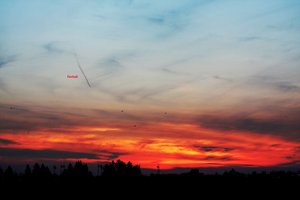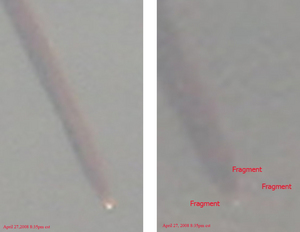Comment: The increased appearance of these Fireballs and Meteors observed across the earth may not be as rare as the photographer concludes.
Click on the Images to expand.

|
| ©Bob Johnson |
| Fireball Over Canada |
I get home to process the images to see what I've got, cropped and enlarged the images, turned out quite good actually, something like NASA might have on CNN, well maybe not NASA.. or CNN, but you get the idea.
Fireballs come from a group of particles bigger then the usual specks of dust grains that cause your average meteor shower. They are caused by objects the size of pebbles people, unbelievable, but because of the high rate of speed they hit our atmosphere, up to 160,000 mph they create quite a show. Daytime fireballs usually have smoke trails which start at about 50 miles altitude, they usually burn out around 9-12 miles high. It is very rare that any of the meteoroid reaches the ground to become a meteorite because of something called Ablation, which is when the outer layers of the meteoroid continually vaporize due to the high speed collision with air molecules.
Just a reminder May 1st. Mercury and the Pleiades meet low in the NW. sky 45 mins after Sunset.

|
| ©Bob Johnson |
| Photograph Closeup |



Reader Comments
to our Newsletter